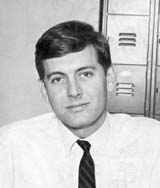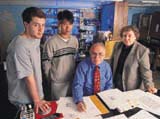


"Tom helped me to see the beauty in science . .
. It was important for me to try to pay back what Tom had given me."
Magazine
Fall 1998
A Promise Kept
Professor Aus Brooks '61 was anxious to oblige his dying friend's request that he oversee the completion of his work. What he needed was a team that could get it done.
When Aus Brooks '61 arrived at Wabash as a freshman in 1957, he knew precisely what he wanted to do with his life-major in political science, move on to law school, and become an attorney. Then the Delt pledge ran into an upperclassman named Tom Cole '58 and his aspirations turned upside down. As one of his first roomheads-actives assigned to keep freshmen in the room on-track with their studies-Cole had an immediate and lasting influence on his fraternity brother.
"Tom helped me to see the beauty in science," the Wabash biology professor explains. "I had no interest or aptitude in it until then. But with Tom's guidance, I became a biology major and worked at Wabash in the lab and field for three summers."
Both Cole and Brooks went on to become accomplished biologists and teachers at Wabash.
"And over the years, Tom was always supportive of my work," Brooks says. "He was a counselor and advisor. When I got stuck on certain problems, he was the person I could go to for suggestions."
So last spring, when Professor Cole was battling pancreatic cancer and asked Brooks if he would be willing to help complete an important part of his scientific work in microbiology, Brooks didn't hesitate to oblige. But keeping his promise to his friend and colleague would depend on a team of students, alumni, the expertise of Cole's long-time research assistant Melva Henninger, and the advice and encouragement of Cole himself.
The work the team undertook actually dates back to an earlier Wabash biology department legend-Professor Willis Johnson. It was Johnson who first interested Cole-first as a student and then as a junior faculty member at Wabash-in the study of protozoa. The young biologist took a slightly different path than his mentor, pursuing the biochemical study of the slipper-shaped protozoan, paramecium. Cole was determined to use the techniques of molecular biology to find a simple alternative to the current tedious, time-consuming, and often inaccurate method of identifying different species of paramecium. For more than a decade, Cole, Henninger, and groups of Wabash students had poured hours into devising a new method. Finally they hit upon a way of making these identifications through the use of DNA "fingerprinting" techniques-reading the unique signature the DNA of different species of paramecium leave when their DNA is exposed to ultraviolet light.
Cole's team had successfully extracted the DNA from a number of paramecium species. But every time they'd expose the sample to UV light for a reading, the "signature" would smear, making identification impossible. That's when Brooks stepped into the picture, offering advice and encouragement, managing weekly lab meetings, and promising to provide Cole's team with whatever supplies they needed to complete the work.
Brooks says it was Henninger who first recognized the cause of the signature smearing. She noticed that, when placed in a low-salt solution, a portion of the extracted sample settled to the bottom, while another portion other floated to the top. Henninger waited for the solution to settle, spooled the top portion onto her slide, and exposed the gel to UV light. The smearing lessened, though the signature was still not as clear as it needed to be.
But what was the material at the bottom of the sample? When spooled onto a gel and exposed to UV light, it resulted in a badly smeared signature. The team began to suspect that this material wasn't DNA, but RNA, yet they needed a way to confirm this.
So Brooks sent a message out over Cole's internet molecular biology/biochemistry list-serve requesting help from Wabash alumni who had been Cole's former students. Several scientists replied, but it was Byron Kemper '65, currently a professor and researcher at the University of Illinois, who had the solution. The test he suggested proved that the material at the bottom of the sample was RNA-there was no need to use any of it in identification process. And an enzyme called RNAase was just the rinse needed to completely cleanse the DNA sample of the RNA. Once that rinse was completed, a clear, indentifiable signature was produced everytime. The team had completed Cole's work, developing and testing a simple and quick method of identifying paramecium species that could have among its uses applications in medical research, including the testing of antibiotics and treatments for diabetes and hypertension.
Professor Cole did not live to see the final results of the work, but Brooks says his friend was heartened by the team's work.
"I think it really did mean a lot to him," Brooks says. "Not just that we were finishing up the work, but that we were actually making progress. I would go over every week and tell him about the progress of the week's work, where we were and what we had been able to do. At first, he was able to really offer suggestions, and we'd go back and try them. As things progressed, of course, he was less able to make contributions, but he was always interested, and, said 'I'm so happy it's moving forward.'"
The team continues to move the work forward. In November, Charles Lee '99 made a presentation of the method to the Indiana Academy of Science, and the group has prepared a paper for submission to the The Journal Eukaryotic Microbiology this winter. The co-authors will be many of those who contributed to the work in recent years, including Melva Henninger, Robert Dirks '99, Thaw Sint '98, Charles Lee '99, David Coates '99, Paul Cornwell '95, and Tom Cole, but Brooks acknowledges that the list could include the dozens of laboratory assistants who have worked on the project during the last decade.
Brooks also presented the work to this year's Ides of August in the scientist-teacher's memory. But he takes little credit. Instead, he sees his involvement as a small part of a link in a chain begun long ago.
"When Willis Johnson was no longer able to continue his research, Tom-both because of the nature of the project and because of his respect and affection for Willis-picked it up and finished it ," Brooks explains. "It was the team that completed Tom's work here, and they deserve the credit. All I did was try to facilitate for them, to make sure they had what they needed. But I'm glad I got to be a small part of it. It was important to me to try to pay back a little of what Tom had given me."
